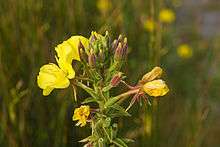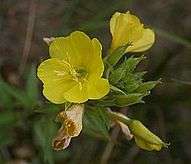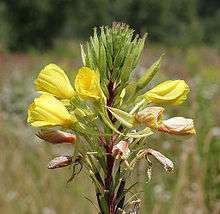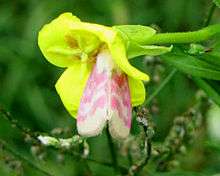Oenothera biennis
| Oenothera biennis | |
|---|---|
 | |
| Scientific classification | |
| Kingdom: | Plantae |
| Clade: | Angiosperms |
| Clade: | Eudicots |
| Clade: | Rosids |
| Order: | Myrtales |
| Family: | Onagraceae |
| Genus: | Oenothera |
| Species: | O. biennis |
| Binomial name | |
| Oenothera biennis | |
| Synonyms[1] | |
| |
Oenothera biennis (common evening-primrose,[2] evening star, sun drop, weedy evening primrose, German rampion, hog weed, King's cure-all, or fever-plant.[3]) is a species of Oenothera native to eastern and central North America, from Newfoundland west to Alberta, southeast to Florida, and southwest to Texas, and widely naturalized elsewhere in temperate and subtropical regions.[4] Evening primrose oil is produced from the plant.[5]
Ecology



Oenothera biennis has a life span of two years (biennial) growing to 30–150 cm (12–59 in) tall. The leaves are lanceolate, 5–20 cm (2–8 in) long and 1–2.5 cm (1⁄2–1 in) broad, produced in a tight rosette the first year, and spirally on a stem the second year.
Blooming lasts from late spring to late summer. The flowers are hermaphrodite, produced on a tall spike and only last until the following noon. They open visibly fast every evening producing an interesting spectacle, hence the name "evening primrose."
The blooms are yellow, 2.5–5 cm (1–2 in) diameter, with four bilobed petals. The flower structure has an invisible to the naked eye bright nectar guide pattern. This pattern is apparent under ultraviolet light and visible to its pollinators, moths, butterflies, and bees.
The fruit is a capsule 2–4 cm (3⁄4–1 1⁄2 in) long and 4–6 mm (0.16–0.24 in) broad, containing numerous 1–2 mm (0.04–0.08 in) long seeds, released when the capsule splits into four sections at maturity.[6][7][8][9]
The seeds of the plant are important food for birds.[10]
Uses
The evening primrose was introduced to Europe in the early 17th century as an ornamental plant in botanical gardens. Its possible applications in the kitchen and as medicinal plant were only discovered more than 100 years later. However, indigenous tribes in North America (namely the Cherokee, Iroquois, Ojibwe and Potawatomi) were using the plant as food and medicinal crop for hundreds of years.[11][12] Today, the evening primrose is mainly known as garden plant and as medicinal plant in specialized sectors.[12][13] However, almost all parts of the evening primrose are edible and medically or cosmetically applicable. This includes the roots, leaves, blossoms, flower buds and seeds.[14]
Food uses
Virtually all plant parts are edible. In general, the taste of the plant is mild but sometimes there can be a rough aftertaste.[14]
The roots can be eaten raw or cooked like potatoes. They can be used from the young plant, from September until the first flowering stem is developed. If soaked in water and boiled the taste is similar to black salsify root.[14]
The leaves of the evening primrose can be used from April to June when the plant is not flowering yet. They can be eaten raw in salads or cooked like spinach or in soups.[14] Several Native American tribes made tea from the evening primrose leaves and used it as a dietary aid.[11] Evening primrose leaves contain flavonoids, mucilages, tannins, sugar, resin and phytosterols.[14]
The flowering stems are preferably used when they are still young in June. They have to be peeled and can then be eaten raw or fried. The flower buds are denoted as delicacy and can be harvested from June to September. They are mild in taste and can be eaten raw in salads, pickled in oil, fried or in soups. The flowers themselves are edible as well and have a sweet taste. They can be used as garnish for salads but also in desserts. When the fruits are still green in August and September they can be used similar to the flowering stems.[14]
The seeds have a protein content of about 15%, an oil content of 24% and contain about 43% cellulose.[15] The proteins are especially rich in the sulphur-containing amino acids methionine and cysteine, as well as in tryptophan - all essential amino acids.[15][16] There is a relative deficiency in lysine and four other essential amino acids. The nutrient of greatest interest is gamma-linolenic acid (GLA), a polyunsaturated fatty acid.[12][13][14][15][17][18] For this reason evening primrose oil is a widely sold dietary supplement. The whole seeds can also be used similar to sesame roasted and in pastries.[14]
Medicinal uses
The oil of mature seeds contains approximately 7-10% of GLA.[17][18][19] GLA, also referred to as C18:3-ω6 fatty acid,[13][15] is not an essential fatty acid because it can readily be created from linoleic acid (C18:2-ω6). GLA is a preliminary stage in the production of prostaglandin, which is essential for the proper functioning of a cell. Symptoms and diseases like endogenous eczema, the Sjögren-syndrome, premenstrual syndrome (PMS), polyarthritis, multiple sclerosis and menopausal symptoms can be induced by a prostaglandin shortage. In theory, an additional intake of GLA might help to cure these symptoms.[12][20]
The Cochrane Collaboration conducted a meta-analysis of clinical trials studying the effect of orally administered EPO on eczema and concluded that there was no effect.[21] The Mayo Clinic examined evidence for the safety and effectiveness of evening primrose for several conditions; it was considered that there was "good evidence" (grade B, vs "strong evidence", grade A) that it produced a moderate improvement in eczema.[22] Grade C, "unclear", evidence for benefit is listed for other conditions. Research has shown a lack of significant beneficial effects on heart functions. Many conditions for which evening primrose oil is a traditional remedy or there is a theory suggesting efficacy are listed by the Mayo Clinic without comment.[22]
There are conflicting opinions and evidence for the medicinal effects of GLA. The active constituent of EPO, which has been promoted to treat ailments including breast pain and eczema; such marketing was described by the British Medical Journal (BMJ) as ethically dubious—the substance was likely to be remembered as "a remedy for which there is no disease".[23] Another single source suggests that Evening Primrose Oil with adjuvant vitamin E, may reduce breast pain.[24] The BMJ said in 2003 that it was of no use in atopic dermatitis.[25] The American Cancer Society said in 2010 that there was very little evidence for its effectiveness as an anti-cancer agent, for which it is sometimes promoted, and "neither GLA nor other GLA-rich supplements (such as evening primrose oil) have been convincingly shown to be useful in preventing or treating any other health conditions."[26]
Adverse effects
EPO is considered likely to be safe in recommended doses.[27] It may increase the risk of bleeding, a concern for patients with bleeding disorders or taking drugs that may increase bleeding. The Mayo clinic recommends caution in people with seizure disorders or mania, and by pregnant or breastfeeding women, and publishes a long list of possible side-effects.
Traditional medicinal use
The whole plant and especially the leaves were boiled to tea by Native American tribes as a stimulant to treat laziness and against “over fatness”. The tribes also used the roots externally to treat piles and boils. Additionally, they were chewed and rubbed onto the muscles to improve strength.[11]
Agricultural practices
The knowledge of agricultural practices in the cultivation of evening primrose is relatively new and only pertain to the commercialized production of evening primrose seed oil. Information of agricultural practices for the production of root vegetable or other plant parts is not known yet.[13]
The evening primrose prefers sunny, and arid places with loamy soil and occurs below 700 meters above sea level.[14] One important prerequisite is to meet adequate nitrogen requirements. While too high nitrogen levels could lead to a quality and quantity decline of the oil content in the seeds,[13] moderate nitrogen levels lead to increased seed quality and quantity.[17] Since the evening primrose is a light-dependent germinator it is important that the seeds are not planted too deep into the soil (0,5-1,0 cm deep). The cultivation of evening primrose is thus suitable for no-till farming, but the plants require an intense mechanical weed control. The tiny seeds (thousand kernel weight: 0,3 -0,7 g) need approximately two to three weeks to germinate and are therefore very susceptible to the outgrowth of weeds.[13]
Evening primrose seeds can be sown in the first half of April (spring seeds) or from mid-July to mid-August (autumn seeds).[13][17] The time of harvest is approximately 75 to 80 days (spring seeds) or 100 days (autumn seeds) after flowering, and clearly influenced by the plant variety, climate conditions, soil fertility and sowing time.[17][18] The population development and thus seed maturation of the evening primrose is very heterogeneous which is a rather difficult production factor.[13]
There is not much water needed during the vegetation period.[13] A study has shown, that the irrigation with salt water could increase the oil yield and quality in evening primrose seeds. This might be a great opportunity especially in regions with limited water resources. Thus, the evening primrose could be a valuable alternative oil crop in arid regions.[19]
Finally, the cultivation of evening primrose requires a proper field management otherwise the plant can become invasive.[11] If the seeds are used for pharmaceutical purposes it is also very important to grow the evening primrose without any pesticides to avoid any chemical residues.[13]
- rosette
- flowers and fruit capsules
 Primrose moth (Schinia florida) in flower
Primrose moth (Schinia florida) in flower Habitat, dry and sunny
Habitat, dry and sunny
References
| Wikimedia Commons has media related to Oenothera biennis. |
| Wikispecies has information related to Oenothera biennis |
- ↑ "Oenothera biennis". World Checklist of Selected Plant Families (WCSP). Royal Botanic Gardens, Kew. Retrieved 7 December 2014 – via The Plant List.
- ↑ "BSBI List 2007". Botanical Society of Britain and Ireland. Archived from the original (xls) on 2015-01-25. Retrieved 2014-10-17.
- ↑ Blanchan, N. (1922). Wild Flowers Worth Knowing. Project Gutenberg Literary Archive Foundation.
- ↑ "Oenothera biennis". Germplasm Resources Information Network (GRIN). Agricultural Research Service (ARS), United States Department of Agriculture (USDA). Retrieved 17 December 2017.
- ↑ http://nccih.nih.gov/health/eveningprimrose (Retrieved 6/17/13)
- ↑ Borealforest: Oenothera biennis
- ↑ Plants of British Columbia: Oenothera biennis
- ↑ Jepson Flora: Oenothera biennis
- ↑ Ultraviolet Flowers: Oenothera biennis
- ↑ "Oenothera biennis". Native Plant Database. Lady Bird Johnson Wildflower Center, University of Texas at Austin. Retrieved 7 December 2014.
- 1 2 3 4 Immel, D.L. (2001). "Plant Guide: Common Evening Primrose". United States Department of Agriculture (USDA), National Plant Data Center (NRCS) (California, USA): 3.
- 1 2 3 4 Storl, W.-D.; Pfyl, P. (2002). Bekannte und vergessene Gemüse: Heilkunde; Ethnobotanik; Rrezepte. AT-Verlag.
- 1 2 3 4 5 6 7 8 9 10 Hoppe, B. (2009). Handbuch des Arznei-und Gewürzpflanzenbaus. Band 5: Arznei- und Gewürzpflanzen L-Z. Bernburg: Verein für Arznei- und Gewürzpflanzen Saluplanta.
- 1 2 3 4 5 6 7 8 9 Guido, S.; Guthmann, J.; Spiegelberger, R. (2013). Enzyklopädie Essbare Wildpflanzen: 2000 Pflanzen Mitteleuropas. AT-Verlag.
- 1 2 3 4 Hudson, B. (1984). "Evening primrose (Oenothera spp.) oil and seed". Journal of the American Oil Chemists' Society. 61 (3): 540–543. doi:10.1007/bf02677026.
- ↑ Brosnan, J.T.; Brosnan, M.E. (2006). "The sulfur-containing amino acids: an overview". The Journal of Nutrition. 136 (6): 1636S–1640S. doi:10.1093/jn/136.6.1636s. PMID 16702333.
- 1 2 3 4 5 Ghasemnezhad, A.; Honermeier, B. (2008). "Yield, oil constituents, and protein content of evening primrose (Oenothera biennis L.) seeds depending on harvest time, harvest method and nitrogen application". Industrial Crops and Products. 28 (1): 17–23. doi:10.1016/j.indcrop.2007.12.006.
- 1 2 3 Ghasemnezhad, A.; Honermeier, B. (2007). "Seed yield, oil content and fatty acid composition of Oenothera biennis L. affected by harvest date and harvest method". Industrial Crops and Products. 25 (3): 274–281. doi:10.1016/j.indcrop.2006.12.005.
- 1 2 Heuer, B.; Yaniv, Z.; Ravina, I. (2002). "Effect of late salinization of chia (Salvia hispanica), stock (Matthiola tricuspidata) and evening primrose (Oenothera biennis) on their oil content and quality". Industrial Crops and Products. 15 (2): 163–167. doi:10.1016/s0926-6690(01)00107-8.
- ↑ Ziboh, V.A. (2001). "Gamma Linolenic Acid: Recent advances in biotechnology and clinical applications". The American Oil Chemists Society.
- ↑ Bamford, Joel (30 April 2013). "Oral evening primrose oil and borage oil for eczema". Cochrane Database of Systematic Reviews. 2013 (4): CD004416. doi:10.1002/14651858.CD004416.pub2. PMID 23633319.
- 1 2 Mayo Clinic - Drugs and Supplements: Evening primrose (Oenothera spp.) - Evidence
- ↑ Richmond, C. (2003). "David Horrobin". BMJ. 326 (7394): 885. doi:10.1136/bmj.326.7394.885.
- ↑ "Vitamin E and Evening Primrose Oil for Management of Cyclical Mastaglgia: A Randomized Pilot Tudy" (PDF). Alternative Medicine Review. Retrieved September 19, 2015.
- ↑ Smith, R. (2003). "The drugs don't work". BMJ. 327 (7428): 0–h. doi:10.1136/bmj.327.7428.0-h.
- ↑ "Gamma Linolenic Acid". American Cancer Society. 13 May 2010. Retrieved August 2013. Check date values in:
|accessdate=(help) - ↑ Mayo Clinic - Drugs and Supplements: Evening primrose (Oenothera spp.) - Safety
External links
- Profile: Yellow Evening-primrose (Oenothera biennis) Photos, Drawings, Text. (Wild Plants of Winnipeg from Nature Manitoba)